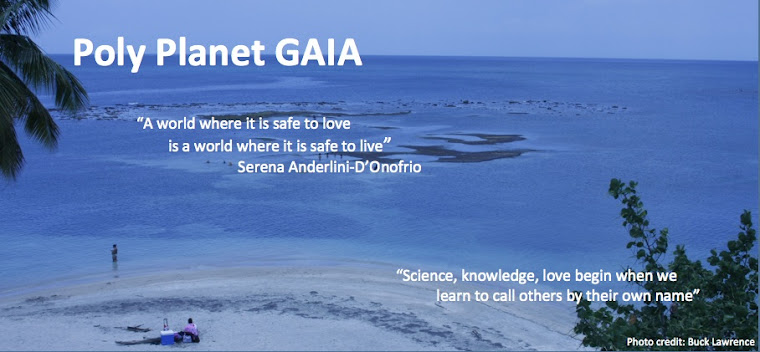You call me ‘promiscuous,’ I call you ‘dishonest,’ a poly person tells the average person who believes that monogamy is the only natural way to love.
You call me ‘denialist,’ I call you ‘believer,’ a dissident person tells the average person who believes that HIV is the only cause of AIDS.
When you call AIDS Dissidents by their own name you exercise leadership in the sexual freedom movement.
Alternative lovestyle communities ignore AIDS Dissidence at their own peril.
From private conversations
Part Eight
“You believe you are a leader in the Polyamory Movement, correct?” asked G as we resumed the conversation.
“Yes,” I replied.
“Yet when you are calling dissidents denialists you are not exercising leadership in the sexual freedom realm.”
“Why not?”
“How would you feel if all of a sudden by some specious misnomer you found you were a leader in the Promiscuity Movement instead?”
“I wouldn’t want to be a leader in that movement, of course.”
“Right. You got it. Wouldn't that misrepresentation of who you are to the world produce a barrier in communication?”
“Yes, it would put me in a place where even affirming my right to exist is a problem, let alone delivering my possibly important message.”
“Yes, it would put me in a place where even affirming my right to exist is a problem, let alone delivering my possibly important message.”
“Now you’re getting it,” G replied, “but there is more to that,” she continued.
“I’m listening,” I said.
“Health and love are related. How we practice love has an effect on our health, and how we keep our health has an effect on how we love. This applies at the individual, the community, and the planetary level, would you agree?”
“Yeah?” I hesitated, not sure what G was getting at.
“Well, the current interpretation of AIDS has kept the world locked in fear for decades. Think of those sex players in the younger generation who’ve never experienced fluid-bonded sex.”
“Ouch!” I said.
“Ouch!” G repeated. “You know how rarely I fluid-bond. And yet, the most remote ever memory of what it feels like, of the complete communion and interpenetration that happens when one makes love freely and all the fluids are exchanged, is what keeps me wanting to stay alive and healthy--so that, if the type of relatedness that warrants fluid-bonding ever arises again, I can do it at no risk for others or myself.”
“I can’t disagree with you on this one G,” I said, “and I don’t know that anyone who has experienced fluid-bonding in a positive way honestly can.”
“So if we can construct, in rigorous scientific terms, another theory of AIDS that interprets fluid-bonding as a message of love--a message of health, then we can use this scientific interpretation as another way to demonstrate how significant Gaia theory is in relation to the diseases that affect us all.”
“Gaia is quite tired of us especially when we don’t seem to listen to the message of her illness and discomfort as manifest in climate change and global warming,” I commented.
“Precisely,” G said, “if we can better learn the arts of loving that allow us to practice fluid-bonding as a form of holistic health for ourselves and our erotic communities, then we can make Gaia more comfortable with our presence, because we will be busy practicing these arts in their various forms rather than frantically consuming products that do not make us happy and contribute to the excessive production that causes climate instability to begin with.”
“What I hear you saying is another version of your sound-bite, ‘a world where it is safe to love is a world where it is safe to live.’ In other words, if we can enlist science to make the world safer for the arts of loving then it will become a world safer to live in as well.”
“Yeah! You got it!” giggles G.
G and I finally giggle together. This has been a heck of a conversation. I feel exhausted. But then, isn’t that the essence of being poly? Endless conversations, debates, open heart disagreements, and that’s how we become cohesive as a movement and we grow.
“What's in a name? You said.”
“Right. What’s in a name?
“The AIDS Dissidence Movement has a name.”
“G, do you mean that calling movements, entities, people by their name is science, it is a form of knowledge we owe others different from ourselves?”
“Yes.”
“Let’s get back to square one then, and begin to see what the argument of your book looks like if the AIDS Dissidence Movement gets to be called by its own name.”
“Let’s.”
“Thank you, G, it’s always good to talk to you. You never seem to give up on thinking with your own head.”
“Sometimes I get headaches,” she giggles.
“I’m sure you do,” we giggle together. “What do you do about it?”
“I use what my friend Alan calls ‘woo woo’ remedies. I get a massage, some craniosacral therapy. I meditate, swim, walk. What about you, my dear, my patient friend, are you ready for the holidays?”
“Yes, G, now I am.”
“I looked at Gaia’s waters today, she’s still patient, and she sends her blessings.”
End of Part Eight, G Tale # 5
End of Tale
A former AIDS patient speaks out on TV, Atheatos Kosmos
Maria Papagiannidou, author of Goodbye AIDS
Disclaimer: This Tale does not constitute medical advice in any way. Readers are invited to consult their own healers and health care providers.
References: For scholarly and scientific references to contents and theories referred to in this dialog, refer to Gaia & the New Politics of Love, whose bibliography lists all sources involved.






